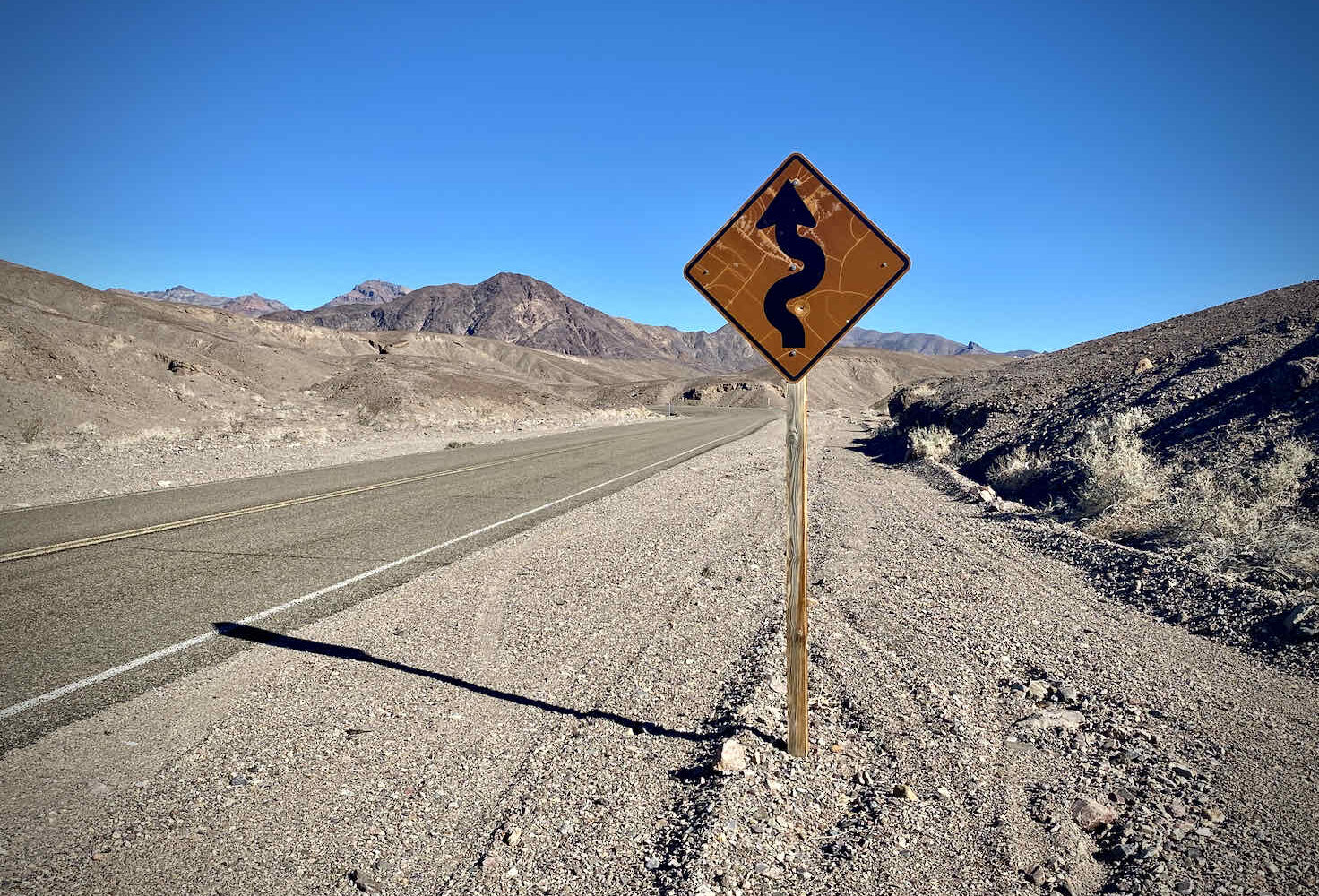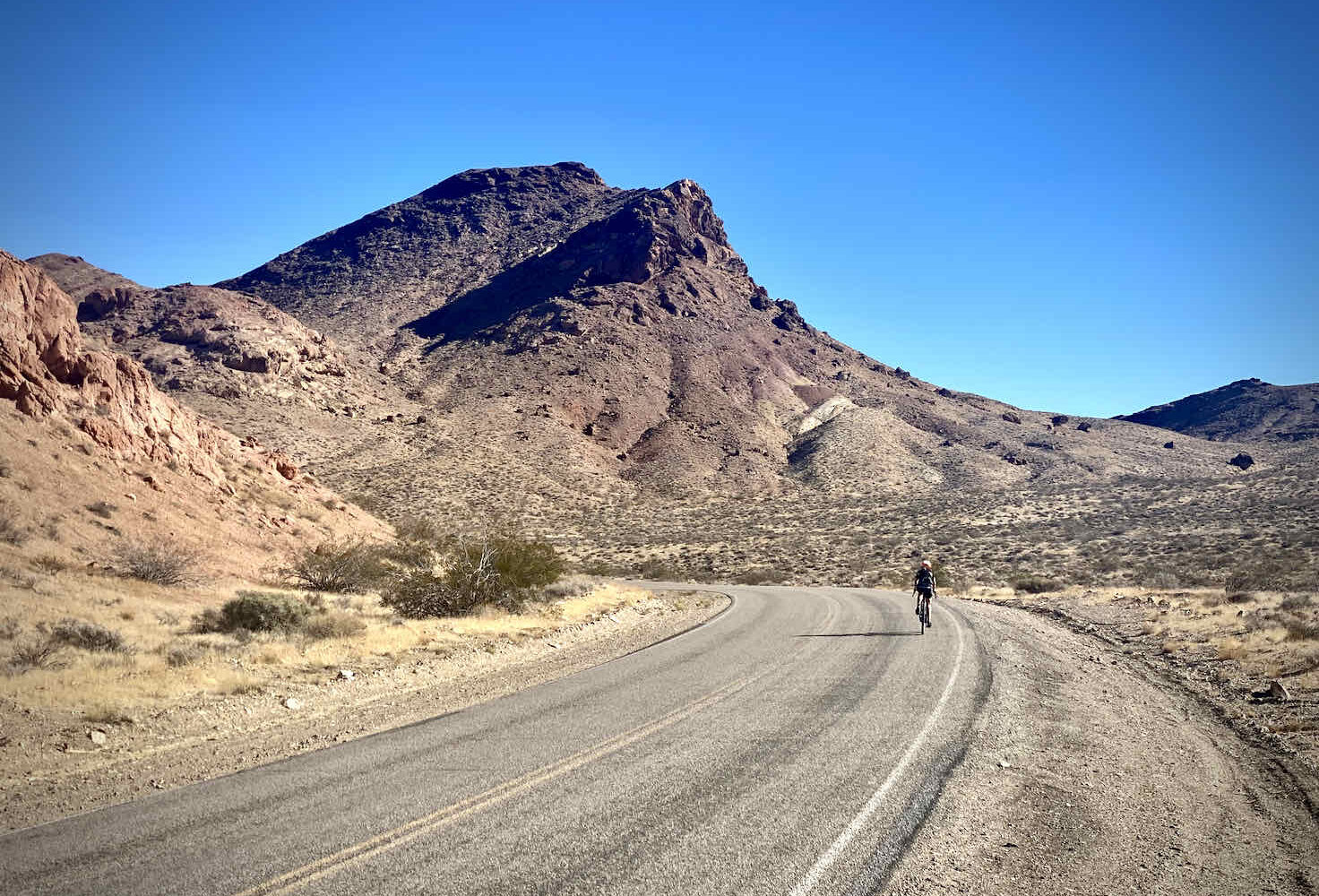Titus Canyon
Closed to vehicles and bikes until at least fall 2026 per National Park Service.
Caution! We do not provide turn-by-turn directions in our GPX files. Those are auto-generated by your bike computer and are usually less than 70% accurate. Learn more.
For help loading a GPX file onto your bike computer, go here.
DownloadHighlights & Remarkable Spots
Daylight Pass Climb and Descent / Miles 0 to 20 / Paved
This is a ride where adjusting tire pressures will be critical to your enjoyment. For this first sector, we recommend that your tires have that hard, stiff road-like feel. For us, on 2.1″ tires, we aired up to 30+ psi, front and rear.
As you leave the parking lot, the climbing kicks in immediately. Be prepared, it is 13 miles with 4100 feet of gain (average gradient of 5.9%) to Daylight Pass. The climbing is continuous and at a very steady gradient.
The climb starts up through a paved wash with distant views of the Grapevine mountains. As you move higher into the climb you are riding up and through the mountains, finally to Daylight Pass.
Most of the Grapevine Mountain chain is in Death Valley National Park. The mountain range is about 22 miles (35 km) long and lies in a northwest-southeasterly direction along the Nevada-California state line. The range reaches an elevation of 8,738 feet (2,663 m) at Grapevine Peak. Daylight Pass is at the southern end of the range.
From the pass, you have a gradual descent of 7 miles dropping 900 feet into the open, barren Amargosa Desert.
The Amargosa Desert is an arid desert habitat between the northern Great Basin and southern Mojave Desert ecosystems. The seasonal Amargosa River course runs through the desert. The first community in the Amargosa Desert was founded circa 1905 as the result of extensive borax mining in the area. In 1907, two railroads started to service the borax, gold, silver, lead and other important mineral mining and processing operations in the surrounding region. As mining yields and economics changed, the railroads became less viable. The Las Vegas and Tonopah line was abandoned in 1918, and the T and T was shut down on June 14, 1940.
For us, miles 15 to 25 were the mental crux of the ride, 10 miles of mostly flat, barren landscape, with the mountains way off in the distance.
Titus Canyon Road / Miles 20 to 46 / Gravel
As you turn onto the gravel at mile 20, we recommend dropping air pressure. For us, that was about 15 psi
This is an entirely one-way road with the exception of the first 3 miles, when you come to the Nevada California border, the beginning of Death Valley National Park. It is marked by a sign and a cattle guard.
Initially, the riding is classic Death Valley dirt road: single lane, some larger chunk, some smaller gravel, most of it’s rounded, some loose sand. You can typically find a good line by looking to the outside edge or center.
At ~ mile 4 the road transitions into the hills and begins to climb more, 5% gradient. At mile 29.5 you summit a ridge, descend 500 feet and begin a second, more demanding climb. It is not that long, but it’s consistently 8 to 10%. And the road is also more beaten up, as cars claw their way up the grade. The summit is Red Pass. It is all downhill from here, 5500 feet.
From the high point down to the mining town of Leadfield is the roughest and most technical section, the road is rocky and steep. Once you enter Titus canyon, it is much more forgiving and the gradient is much less. So it’s quite fast riding.
At about mile 35.5 is the ghost town of Leadfield, a mining boomtown founded on wild and distorted advertising. It was a scam! If you have the time, walk out to the old relics.
Just Leadfield, you enter the canyon proper, a wash that has been graded out to be a road. It is absolutely stunning. But depending on the last time the road was maintained and the rains, it
Partway through the canyon, the wash widens and there is a set of petroglyphs.
The last three miles of gravel, from exiting the canyon to the paved, is rugged and tiresome. It’s a two-lane road. It’s soft. It’s chunky. It’s got some washboards. At this point, you feel the fatigue of the day.
It took us approximately three hours (ride time) to do the entire gravel sector.
Scotty's Catle Road / Miles 46 to 61 / Paved
The last miles are on the paved flats of the valley floor. Remember, this will be in the heat of the day.
At ~ mile 53, there is a pull-out. Here rock, sand, and other debris washed from the mouth of the canyon formed a broad apron of rock, called an alluvial fan. The apron or rock at this kiosk is worth the stop, just to take in the enormity of it.
A bit further along, if you look to the right, you can see the highway from Stovepipe Wells climbing up and over the Panamint Mountains, it is quite impressive.
To finish out your ride, at ~ mile 56 on your left-hand side there are some impressive colored dunes / sculptured rock. Satellite photography shows these holding back the rock and sand from the alluvial fans.
When We Like to Ride This
October to April, when the temperatures are reasonable. Note, the route starts at 200 feet (almost sea level) and climbs to 5200 feet. We recommend an early start, an hour or so after sunrise, to take advantage of the cool temps. The last hour will be in the heat of the day and in the heat of the valley. Save some water for the finishing paved miles.
Terrain & Riding
Rugged desert terrain. Significant climbing. A five-mile sector of canyon riding that is unbelievably beautiful. A stop at a mining ghost town and some petroglyphs.
The Start
At the parking pullout near Scotty’s Castle Road and Daylight Pass Road. Pit toilets. No water.
Food & Water
- None
Route Notes
Death Valley is classic Southwest desert riding with more of a jeep road feel than a classic gravel road; it can vary from hard-pack with embedded rock to loose and course to soft wash sand and washboard. The surfaces are ever changing based on based on maintenance, rains, and time of year. Thus, error on the side of too much tire, rather than not enough. We recommend 50mm / 2.1” tires or larger and an adventure gravel bike versus a more traditional all road gravel bike. Larger, softer tires will handle the wash best. We rode this on a Salsa Cutthroat adventure bike with Rene Herse Fleecer Ridge 2.2″ tires.
For the most current road condtions in the canyon give a call to the National Park Service. Highly recommended!
This is one of the more frequented dirt roads in death valley expect light vehicle traffic.
Check the weather before you go. The paved sectors can get windy! This ride is exposed to both wind and sun.
The gravel sector is one way. And this is the only way you want to ride the route due to (possibly) some really soft sand and wash.
Go prepared! In mid-November, we consumed 70 ounces of water carried in a Camelback and two additional water bottles.
We recommend a red blinky light with rear looking radar detector (i.e. Garmin Varia)
Route Options
An option is to shuttle the route, avoiding the long opening climb. Farabee’s Jeep rentals provides shuttle service. The start location is then at the park border along the beginning of Titus Canyon Road, just before the cattle grate and park sign. (39 miles, 2500 feet of gain, 6000 feet of loss)
Parking Lat / Long: 36.855150, -116.878227





























Have you ridden this route? Got a question? Join the discussion!